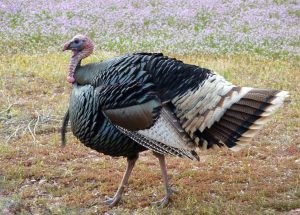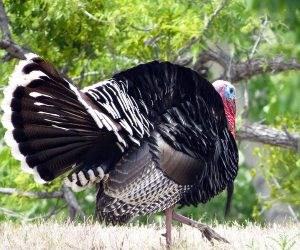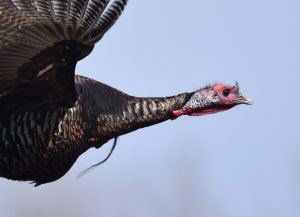This content was originally published by the Longmont Observer and is licensed under a Creative Commons license.
With Thanksgiving coming up this week, I thought I would digress from the usual Longmont wildlife and do a article on wild turkeys instead. From hand tracing turkeys in grade schools to bourbon named after them, wild turkeys are prevalent this time of year in our consciousness. But did you know that our love of turkey for Thanksgiving caused a drastic decline in the population? Or that, reportedly, Ben Franklin wanted the wild turkey as the national bird instead of the eagle?
There are only two species of domesticated birds that are native to the New World, the Muscovy duck and the wild turkey. The native people of Mexico domesticated the turkey and in the 1500’s, European explorers brought the wild turkey back home where they became a popular menu item. When the colonists came to North America, they brought domesticated wild turkeys with them. It is believed that the name turkey came about because the birds were shipped through the ports of Turkey on their way to Europe.
Colorado itself is home to two subspecies of wild turkey. One species, the Merriam, is found west of I-25 in the foothills and mountain meadows. The other, the Rio Grande, was introduced to the eastern plains and can be found along riparian corridors.

Turkeys have a distinctive profile, being large, plump birds. Their tails are rounded, they have long legs, and a small head. Their feathers are dark overall with a bronze-green iridescence. Wings have white bars on them, and their tail and rump feathers are also tipped with either white or rust. The head and neck are bare and vary in color from red to blue to gray.
You will most likely find wild turkeys where there are old forests of oak, hickory, or beech where there are also fields or clearings that create edges with the forest. They may also be seen along roadsides or in woody backyards. At one time, wild turkeys were nearly hunted out of their range, but reintroduction programs have brought the populations back in most areas. Turkeys are present in 49 states and parts of Canada.
Wild turkeys forage in flocks for plant matter primarily on the ground. Occasionally, they will climb into small trees and shrubs to eat fruit. During the fall and winter when there is less food available, they will scratch the ground looking for nuts, seeds, and berries. If these food sources are scarce in the springtime, they may also dig up bulbs to eat. When snow covers the ground, wild turkeys eat buds, ferns, and mosses. They may also occasionally eat insects and salamanders. Wild turkeys need grit to help them digest their food, and they primarily feed during the early morning and evening.

In the spring, males begin displaying to attract females. In addition to a gobbling call, the males puff out their feathers, spread their tails, swell their face wattles, and droop their wings. They will strut around in this posture while rattling their wings and making a humming sound. Males mate with more than one female.
Wild turkeys nest on the ground at the base of trees, under thick shrubbery or brush piles, and occasionally in open fields. They only use the materials present at the nest site to construct their nest which is simply a shallow depression scraped in the ground lines with dead leaves and plant materials.
Females typically lay 10-15 eggs and occasionally more than one female may lay eggs in a single nest. Incubation lasts 25-31 days. The young are downy when hatched and are able to leave the nest shortly after hatching (also known as altricial). Males do not participate in rearing the young and will form all male flocks outside of breeding season. The female will feed the young for a few days until the young are able to find food on their own. Females brood the young for several weeks at night. Eventually, the chicks and females will form larger groups with other chicks and females. Although they will not be fully grown for several months, the young can make short flights at one to two weeks of age.

Wild turkeys roost in trees at night in flocks although they may be found roosting individually. Female flocks have a stable hierarchy while male flocks have a constantly changing hierarchy.
The primary form of locomotion for wild turkeys is walking. However, they are capable of running and flying when threatened. Typically, it is the female that flies when threatened whereas the male runs. Wild turkeys can run up to 25 miles per hour and can fly up to 60 miles per hour. Incredibly, they are capable of swimming when necessary.
Populations of wild turkeys began to decline in the nineteenth and early twentieth centuries due to hunting and habitat loss. Initial efforts to recover the population included releasing farm turkeys into the wild, but these efforts failed. Finally, conservationists were successful by transplanting wild turkeys from one location to another in the 1940s. Colorado began an aggressive reintroduction campaign in the 1980s and wild turkeys are now found in 53 of 64 counties. In California, there are suburban populations of wild turkeys that some people dislike because of the mess they leave with their droppings. They have also been known to chase people, dig up gardens, and dent car fenders. Urban wild turkey populations are popping up in other states as well such as Michigan and New York.
I’ll end this column with a silly Thanksgiving joke for your kids. Why did the turkey get arrested? The police suspected him of fowl play! Enjoy the day with your family and friends!


